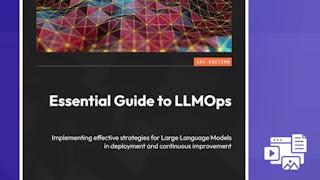In this comprehensive course, you will explore the intricate world of Large Language Models (LLMs) and gain the skills to design, train, and deploy them using cutting-edge MLOps practices. LLMs are revolutionizing the AI landscape, and understanding how to develop and manage them is essential for AI professionals.

Enjoy unlimited growth with a year of Coursera Plus for $199 (regularly $399). Save now.

Recommended experience
What you'll learn
Design and manage effective LLM training and deployment pipelines.
Implement supervised fine-tuning and evaluate LLM performance.
Deploy scalable, end-to-end LLM applications using cloud tools.
Skills you'll gain
Details to know

Add to your LinkedIn profile
November 2025
11 assignments
See how employees at top companies are mastering in-demand skills

There are 11 modules in this course
In this section, we delve into the concept and architecture of LLM Twin, an innovative AI model mimicking a person's writing style and personality. We discuss its significance, benefits over generic chatbots, and the planning process for creating an effective LLM product. Detailed insights into the design of the feature, training, and inference pipelines are explored to structure a robust ML system.
What's included
2 videos3 readings1 assignment
In this section, we introduce the essential tools needed for the course, particularly for the LLM Twin project. We provide an overview of the tech stack, cover installation procedures for Python and its ecosystem, dependency management with Poetry, and task execution using Poe the Poet. This section also provides insights into MLOps and LLMOps tooling, including ZenML and Hugging Face, and explains their roles in the project. Finally, we guide users in setting up an AWS account, focusing on SageMaker for deploying ML models.
What's included
1 video2 readings1 assignment
In this section, we delve into the LLM Twin project by designing a data collection pipeline for gathering raw data essential for LLM use cases, such as fine-tuning and inference. We'll focus on implementing an ETL pipeline that aggregates data from platforms like Medium and GitHub into a MongoDB data warehouse, thus simulating real-world machine learning project scenarios.
What's included
1 video4 readings1 assignment
In this section, we explore the Retrieval-augmented Generation (RAG) feature pipeline, a crucial technique for embedding custom data into large language models without constant fine-tuning. We introduce the fundamental components of a naive RAG system, such as chunking, embedding, and vector databases. We also delve into LLM Twin's RAG feature pipeline architecture, applying theoretical concepts through practical implementation, and discuss the importance of RAG for addressing issues like model hallucinations and old data. This section provides in-depth insights into advanced RAG techniques and the role of batch pipelines in syncing data for improved accuracy.
What's included
1 video7 readings1 assignment
In this section, we will explore the process of Supervised Fine-Tuning (SFT) for Large Language Models (LLMs). We'll delve into the creation of instruction datasets and how they are used to refine LLMs for specific tasks. This section covers the steps involved in crafting these datasets, the importance of data quality, and presents various techniques and strategies for enhancing the fine-tuning process. Our focus will be on transforming general-purpose models into specialized assistants through SFT, enabling them to provide more coherent and relevant responses.
What's included
1 video7 readings1 assignment
In this section, we delve into the realms of preference alignment, discussing how Direct Preference Optimization (DPO) can fine-tune language models to better align with human preferences. We elaborate on creating and evaluating preference datasets, ensuring our models capture nuanced human interactions.
What's included
1 video4 readings1 assignment
In this section, we delve into the evaluation of large language models (LLMs), addressing various evaluation methods and their significance. We cover general-purpose, domain-specific, and task-specific evaluations, highlighting the unique challenges each presents. Additionally, we explore retrieval-augmented generation (RAG) pipelines and introduce tools like Ragas and ARES for comprehensive LLM assessment.
What's included
1 video3 readings1 assignment
In this section, we dive into the art of fine-tuning large language models to boost their performance and efficiency. We'll explore key strategies to optimize the inference process of these models, a crucial step given their heavy computational and memory demands. From reducing latency to improving throughput and minimizing memory usage, we examine how to deploy specialized hardware and innovative techniques to enhance model output. By learning these optimization secrets, you'll unlock more efficient deployments, be they for fast-response tasks like code completion or document generation in batches.
What's included
1 video3 readings1 assignment
In this section, we explore the construction and implementation of a RAG inference pipeline, starting from understanding its architecture to implementing key modules such as retrieval, prompt creation, and interaction with the LLM. We introduce methods for optimizing retrieval processes like query expansion and self-querying while utilizing OpenAI's API, and integrate these techniques into a comprehensive retrieval module. We'll conclude by assembling these elements into a cohesive inference pipeline and preparing for further deployment steps.
What's included
1 video5 readings1 assignment
In this section, we focus on deploying the inference pipeline for large language models (LLMs) in ML applications, ensuring models are accessible and efficient for end users. We'll cover deployment strategies, architectural decisions, and optimization techniques to address challenges like computing power and feature access.
What's included
1 video5 readings1 assignment
In this section, we dive into the intricacies of MLOps and LLMOps, exploring their roles in automating machine learning processes and handling large language models. We will cover their origins in DevOps, highlight the unique challenges LLMOps addresses, such as prompt management and scaling issues, and illustrate the practical steps for deploying these systems efficiently. The section also includes discussions on the transition from manual deployment to cloud-based solutions, emphasizing the advantages of CI/CD pipelines and Dockerization in executing and managing models at scale.
What's included
1 video7 readings1 assignment
Instructor

Offered by
Explore more from Data Analysis
 Status: Free Trial
Status: Free Trial Status: Free Trial
Status: Free TrialDuke University
Why people choose Coursera for their career





Open new doors with Coursera Plus
Unlimited access to 10,000+ world-class courses, hands-on projects, and job-ready certificate programs - all included in your subscription
Advance your career with an online degree
Earn a degree from world-class universities - 100% online
Join over 3,400 global companies that choose Coursera for Business
Upskill your employees to excel in the digital economy
Frequently asked questions
Yes, you can preview the first video and view the syllabus before you enroll. You must purchase the course to access content not included in the preview.
If you decide to enroll in the course before the session start date, you will have access to all of the lecture videos and readings for the course. You’ll be able to submit assignments once the session starts.
Once you enroll and your session begins, you will have access to all videos and other resources, including reading items and the course discussion forum. You’ll be able to view and submit practice assessments, and complete required graded assignments to earn a grade and a Course Certificate.
More questions
Financial aid available,



